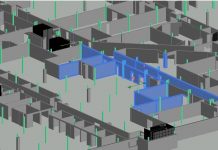Stephen Bartlett, CEO of Invigilatis discusses how BIM is approached by FM in healthcare
The journey/vision
Given the government’s imminent deadline (end 2016) for Level 2 BIM, new and exciting ways of working will soon be available to NHS Estates and Facilities teams. However, given today’s exceedingly tight finances, it may still be many years, possibly decades, before a significant proportion of the NHS estate is managed via BIM models. During those transitional years Estates and Facilities managers must continue to deliver effective services which satisfy the increasing demands of the Excel-based Premises Assurance Model, while on the other hand, progressing to exploit the latest technologies which underpin BIM solutions. Inevitably this eclectic mix of technology will stretch their operational resources, whereas Capital Project colleagues will be able to make a clean break with the past, working only on BIM-based projects.
BIM is also expected to yield many financial and operational benefits. Ongoing maintenance benefits, though monetarily small in comparison to the initial project stage benefits, will recur over many years and so they may ultimately yield the largest value benefit to be included in any Cost Benefit Analysis. For this reason, it is vitally important those benefits are understood and correctly evaluated.
Your starting point?
Many Trusts will need to progress quickly from today’s plethora of poorly deployed legacy software. Often populated with muddled and incomplete data, reporting from those systems is commensurately poor, despite considerable efforts from overworked Estates Officers who have to manipulate data in ever-more complex Excel models. There is a great deal to do!
Readers may recognise the symptoms – multiple similar but slightly different location listings, incomplete asset information and poor maintenance records, all of which make it impossible to achieve either effective Asset Management processes or reliable Compliance reporting. (N.B. These problems are not only confined to estate records for older properties!) Beyond Level 2, BIM Level 3 is expected to overcome traditional disconnects: with all the project professionals working collaboratively to establish a comprehensive 3D building model including details of all the assets, which the Estates and Facilities Management team will subsequently maintain. Fantastic – but, unfortunately details of the existing estate will not be in the model and the building model information will need to be integrated with existing Maintenance and Compliance systems.
Consequently, the deployment of BIM results in yet another challenge for Estates and Facilities Management teams. While potentially exciting, BIM may be viewed as a low priority because many Trusts face more pressing challenges due to outsourcing of compliance, with their various inspections recorded and held in a multiplicity of systems both internal and external. Despite those data silos mostly running on standard databases, integration is practically impossible because much of the core data does not map between the systems. Therefore, sadly, the assembly of useful information is almost always done manually and essential reporting is extremely time-consuming.
Invigilatis – How can we help?
Having recognised the fundamental compliance issues and requirements, Invigilatis was formed 3 years ago specifically to support Trusts to exploit the full potential of technology and improve their reporting. In turn, this allows Trusts to focus on CQC’s goals to improve the Patient Safety and Satisfaction by ensuring services are safe, secure, effective, responsive and well-led.
Invigilatis provides two options:
Integration Services – more of the same – possibly another elastoplast?
Simply integrating existing systems sounds relatively easy but is likely to yield an extremely complex solution which never really gets to the root of many Trusts’ problems – i.e. poor quality data.
Invigilatis has considerable experience of system integration. By deploying its Compliance Framework, together with the Microsoft BI stack, it is possible to bring Trusts’ data together. However, while reporting may improve, existing data handling routines involving multiple data sets, with the prospects of repeated errors and inefficiencies will still persist.
An integrated System – starting afresh – clean and simple!
Effective asset management and efficient operations are possible with Invigilatis integrated environment which is ideally suited to receive BIM input. Therefore, best value is achieved by deploying Invigilatis’ integrated solution – Seeker – which is available as a GCloud Service and encompasses:
• Property Management;
• Estates and Facilities;
• Compliance.
Invigilatis is a proven innovator. Seeker’s core capabilities were developed specifically for healthcare. Evolving from NHS Confederation’s WIMS system, Seeker was the first windows-based FM system deployed in major hospitals, and the first solution to exploit SVG to make floor plans accessible to entire Trusts’ staff, making it easier for all staff to visualise space availability, occupancy and utilisation. Invigilatis’ integrated solution was developed in conjunction with Haringey PCT and with guidance from London Strategic Health Authority during 2010. Haringey’s aim was to improve the space management of its inner city estate, while providing also both its Commissioners and Service Providers real time information about where best to deliver services. Also, with a better appreciation of assets and compliance, users made better informed choices about the spaces they required for the delivery of safe services.
Subsequently, Invigilatis’ innovative Compliance Framework has been extended to include standard checks on Asbestos, Legionella, and Fire Safety. The framework is extremely flexible and can accommodate any other space/asset based inspections for either hard or soft FM – enabling Trusts to continue with their existing compliance checks and not abandon years of historic information.
The framework also contains the Canty Compliance audits which cover the main HTMs, along dynamic risk assessments and a set of safety rules and procedures. It has been integrated with the SFG’s PPMs and linked to the PAM, so that trusts can use just one system to audit and evidence all aspects of compliance and their overall performance.
Clinical staff can also use the framework: a Control of Infection module contains both the Infection Prevention Society QIT checklists and the previous ICNA audits, together with audits developed with the Medical Protection Society for use with GP practices and Out of Hours services.
In Conclusion
Expectations are high as the BIM Level 2 deadline approaches. It is seen as a milestone in Estates’ IT deployments and Trusts will be expected to show corresponding improvements in their reporting. Invigilatis can help achieve that data harvesting goal and more! By exploiting the associated wealth of knowledge in the BIM model, users will then be able to query the model via predictive tools to gain a better understanding of vital patient safety issues.
Stephen Bartlett
CEO
Invigilatis
Tel: 07899955658
stephen.bartlett@invigilatis.com








